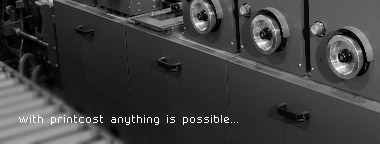I’ve interrupted the series I started last month on the standard buttons on a Printcost browse screen to explain allocating credit type transactions, because recently more than one of our clients has had problems with this. The specifics of this only applies to Printcost accounts receivable but the generality may have relevance to other accounting packages.
Most accounts receivable systems now operate as open item systems. That is that every transaction that is active is reported on the customer statement at the end of the month. An active transaction is normally one that either still has an amount outstanding (an invoice that has not been completely paid) or a transaction that has been completed this month or a transaction that has been posted this month. This is the Printcost normal although it is not the only definition for transactions that appear on your customers statements.
With an open item system it is necessary to tell the computer which invoices (or debits) have been paid when a receipt (or credit) is processed. This is the process we call allocation. Allocation can only change the “ageing” figures on a customers account, it cannot change the total owed.
Processing a receipt or credit will reduce the amount you show as being owed by the customer. The only time you should process a receipt is when you have received cash, cheques, or other forms of actual payments, or when you are processing electronic transactions reported to you from the bank (either electronically or on the bank statement). You should never process a receipt based on a remittance advice from a customer. You should have a system in place that ensures you do not process receipts twice – that is almost like paying twice for goods or services (we all think that only happens to the other guy but I have seen enough debtors ledgers where customers have paid twice – and are in credit – to not believe it couldn’t happen to us or any one of our clients, but that is another story).
Processing a credit should only be done when you want to reduce the overall amount a customer owes you. This is giving the customer back money so don’t do it lightly.
You should never process a credit or receipt because you “know” an invoice has been paid and it appears to be still outstanding on the customer’s file. If an invoice appears to be still outstanding, and you have followed your normal process for banking and credits then the likely cause is you have not allocated the receipts or credits. If you have this situation, click on the activity button for this customer. If the list of transactions is too long you can click the sel button then add the “receipts / credits to be allocated” quick pick and click OK. These transactions should then be allocated. If no transactions show on this list then it is possible you have allocated the transactions wrongly. Go back to the customer and select activity again.
Find the receipt or credit that you believe paid this invoice and click details, Check the box “show allocation” and this will show you what that receipt was allocated to. If it was wrong then you can use the reverse allocation button and re-allocate the transaction correctly.
Another reason the invoice may still appear to be wrong is that the receipt (or credit) may have been put on hold or have not been posted. There are quick picks for “entered” transactions and for “on hold” transactions that can help you find these.
As a last resort you can rebuild the trial balance. To do this first do a balance check and print the results. If it shows an error do not proceed any further, otherwise perform the rebuild trial balance function and then do another balance check and ensure the overall balance is the same as in the first balance check. If it is not the same or has errors, then contact the Printcost help desk immediately for further assistance.
If a rebuild does not fix your problem then you have not entered and posted the receipt or credit, or you have allocated it wrongly. The only way to check this is manually review the transactions for this customer.
When you allocate a transaction (and you can only allocate receipt or credit transactions) you need to select the debit transaction(s) that it applies to. On the transaction details screen, tick the “allocate” check box on and then click in the “allocation” column of the first transaction you want to allocate to (in normal circumstances this will be the first transaction in the list). Printcost will default a value into this entry box. If the transactions periods match (and remember that a receipt with a blank period matches all periods - blank is not the same as zero) then the value will be the smaller of the amount outstanding on two transactions (the receipt or credit you are allocating and the invoice or debit). If the periods don’t match the amount will be zero. In either case you may change the allocation amount but you will not be allowed to allocate more then is outstanding on either transaction. To complete the allocation press the enter key and the cursor will move to the next line. To skip an allocation you can press an arrow key or click elsewhere.
There is also an “auto allocate” function. This will automatically allocate all the credit type transactions on the browse list according to the default values explained above.
Transactions not fully allocated will continue to appear on your customers statements, even if there is only one or two cents outstanding. If a customer has overpaid by a cent (or even more) you may need to create and post a debit (same way you create and post a receipt except you click the debit radio button). If you account for GST on an invoice basis you should separate the GST on the debit.
And finally it is good housekeeping at the end of the month to check all “receipts / credits to be allocated” – click on the sel button, click reset then click the quick pick and OK. If you have allocated all transactions correctly, then this list of transactions should be small and should only be transactions for customers who are in credit. You should also check for any “entered” transactions (these have been entered and maybe allocated but not posted so they have not been “actioned”) and following month end you should check for any on hold transactions and post these.
If you want to comment or suggest a topic for ‘tip of the month’, contact Chris on email cc@printcost.com


